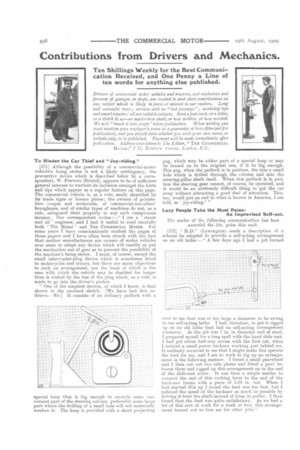Contributions from Drivers and Mechanics.
Page 20

If you've noticed an error in this article please click here to report it so we can fix it.
Ten Shillings Weekly for the Best Communication Received, and One Penny a Line of ten words for anything else published.
Drivers of commercial motor vehicles and tractors, and mechanics and foremen of garages or shops, are invited to send short contributions on any subject which is likely to prove of interest to our readers. Long and successful runs ; services with no "lost journeys"; workshop tips and smart repairs : all are suitable subjects. Send a post-card, or a letter, or a sketch to us—no matter how short, or how written, or how worded. We will knock it into shape" before publication_ When writing you must mention your employers name as a guarantee of bona fides (not for ,bublication), and you should state whether you wish your own name, or initials only, to be published. Payment will be made immediately after publgcation. Address your letters to I he Editor, " THE COMMERCIAL Moroa," 7 15, Roubere Avenue, Landun, E.C.
To Hinder the Car Thief and "Joy-riding."
[571] Although the possibility of a commercial-motor vehicle's being stolen is not a likely contingency, the preventive device which is described below by a correspondent, W. PONTING (Bristol), appears to be of sufficient general interest to warrant its inclusion amongst the hints and tips which appear as a regular feature on this page. The commercial vehicle is, as a rule, easily identified by its trade signs or licence plates; the owners of private. hire coupes and motorcabs, of commercial-travellers' broughams, and of similar types of machines do not, as a rule, safeguard their property in any such conspicuous . manner. Our correspondent writes :—" I am a 'steam and oil ' engineer, and I find it useful to read carefully both The Motor ' and THE COMMERCIAL MOTOR. For some years I have conscientiously studied the pages of these papers and I have often been struck with the fact that neither manufacturers nor owners of motor vehicles ever seem to adopt any device which will readily so put the mechanism out of gear as to prevent the possibility of the machine's being stolen. I must, of course, except the small interrupter-plug device which is sometimes fitted to motorcycles and tricars, but there are many objections to such an arrangement, not the least of which is the ease with which the vehicle may be disabled for longer than is wished by the loss of the plug which, as a rule, is made to go into the driver's pocket.
" One of the simplest devices, of which I know, is that shown in the enclosed sketch. [We have had this redrawn.—En.] It consists of an ordinary padlock with a
• special hasp that is big enough to encircle some convenient part of the steering column, preferably some large part where the drilling of a small hole will not materially 'weaken it. The hasp is provided with a short projecting
peg, which may be either part of a special hasp or may be brazed on to the original one, if it be big enough. This peg, when the padlock is in position, fits into a small hole which is drilled through the column and into the steering-pillar shaft itself. When this padlock is in position the steering gear cannot, of course, be operated, and it would be an exteemely difficult thing to get the car away without attracting a good deal of attention. This, too, would put an end to what is known in America, I am told, as joy-riding.' "
Lazy People Take the Most Pains: An Improvised Self-act.
The sender of the following communication has been awarded the 10s. prise this week.
{:572] " 11.D." (Lymington) sends a description of a scheme he adopted to provide a self-acting arrangement on an old lathe:—" A few days ago I had a job turned over to ine that was of too large a diameter to be swung in our self-acting lathe. I had, therefore, to get it rigged up on an old lathe that had no self-acting arrangement whatever. As the job was 7 in. in diameter and of steel, I prepared myself for a long spell with the hand slide rest. I had got about half-way across with the first cut, when I noticed a small power hacksaw working just behind me. It suddenly occurred to me that I might make this operate the feed for me, and I set to work to rig up an arrangement in the following manner. I found a small gearwheel and I then cut out two side plates and fitted a pawl between them and rigged up this arrangement on to the end of the slide-rest screw. It was then a simple matter to connect the end of this rocking lever to the end of the hack-saw frame with a piece of 5-16 in. rod. When I first started this up I found the feed was too fast, but I reduced the speed of the hacksaw as much as possible by driving it from the shaft instead of from its pulley. I then found that the feed was quite satisfactory. As we had a lot of this sort of work for a week or two, this arrangement turned out to free me for other jobs."






















